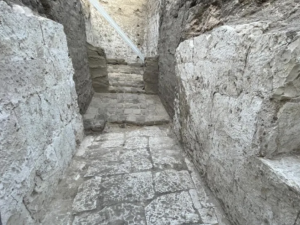This was the end of the Second Intermediate Period -- "a very murky period" in Egyptian history, when many kings survived only a few years after taking the throne, Wegner says.
這是第二中間期的末期--韋格納說,這是埃及歷史上“非常模糊不清的時期”,當時許多國王在登上王位后僅僅存活了幾年。
The Nile Delta and most of Egypt north of Abydos were ruled at this time by the Hyksos -- a foreign dynasty from the East -- while most of the south was ruled by pharaohs from the ancient city of Thebes, a center of worship of the creator god Amun.
在這個時期,尼羅河三角洲以及阿拜多斯以北的埃及大部分地區由喜克索斯人統治--這是一個來自東方的外族王朝,而南部的大部分地區則由來自古城底比斯的法老統治,底比斯是崇拜創造之神阿蒙的中心。
Little is known about the "lost" dynasty that ruled at Abydos during this time, and it seems only Senebkay was recorded in the traditional lists of ancient Egyptian kings.
對于在這個時期統治阿拜多斯的 “失落” 王朝,人們所知甚少,而且似乎只有塞內布凱被記錄在古埃及國王的傳統名單中。
The newfound tomb at Abydos is a little older than the Senebkay tomb, and it may have been for one of his ancestors -- although the title of pharaoh did not always pass from father to son.
在阿拜多斯新發現的這座陵墓比塞內布凱的陵墓年代稍早一些,它可能是為塞內布凱的某位祖先建造的--盡管法老的頭銜并不總是父子相傳。
The structure now lies beneath about 20 feet of sand, with limestone walls cut into bedrock and a vaulted ceiling of mud-bricks.
這座建筑如今位于約20英尺厚的沙土之下,石灰巖墻壁嵌入基巖,泥磚構成拱形天花板。
No human remains were found in the tomb, and so no ancient DNA studies will be possible, Wegner says.
韋格納說,在陵墓中沒有發現人類遺骸,因此無法進行古代DNA研究。

The tomb's location, massive size, and hieroglyphic inscriptions written in plaster on bricks at the entrance to the limestone chamber identified it as the resting place of a pharaoh.
這座陵墓的位置、巨大的規模,以及在石灰巖墓室入口處磚墻上用灰泥書寫的象形文字銘文,都表明這里是一位法老的安息之地。
Those inscriptions invoke the goddesses Isis and Nephthys, but the name of the king entombed there could not be read, Wegner says.
韋格納說,這些銘文提到了伊西斯和奈芙蒂斯兩位女神,但無法辨認出安葬在此處的國王的名字。
The newfound tomb is much larger than Senebkay's tomb, which suggests it may have been for one of the dynasty's founding kings.
新發現的這座陵墓比塞內布凱的陵墓大得多,這表明它可能是為該王朝的某位開國君主建造的。
It was extensively looted by tomb robbers in antiquity, and so now no grave goods, sarcophagus, nor mummy remains. But what survives hints at its lost splendor.
在古代,這座陵墓曾遭到盜墓者的大規模洗劫,因此現在沒有陪葬品、石棺,也沒有木乃伊殘骸留存下來。但現存的遺跡仍能讓人聯想到它昔日的輝煌。
"I think it would have been a very richly-equipped burial for this period in ancient Egypt," Wegner says. "The architecture is quite impressive, so I think it probably attracted tomb robbery relatively early, and probably multiple times."
“我認為對于古埃及的這個時期來說,這原本應該是一次陪葬品非常豐富的墓葬,”韋格納說,“它的建筑相當令人印象深刻,所以我認為它可能很早就吸引了盜墓者,而且可能被盜過多次。”
The tomb's architecture and its decorations deepen the modern understanding of funerary practices "in this very ancient and sacred cemetery," says Anna-Latifa Mourad-Cizek, a historian and archaeologist at the University of Chicago who was not involved in the discovery.
芝加哥大學的歷史學家和考古學家安娜-拉蒂法·穆拉德-奇澤克并未參與此次發現,她說這座陵墓的建筑及其裝飾加深了現代人對“在這個非常古老且神圣的墓地”中葬禮習俗的理解。












